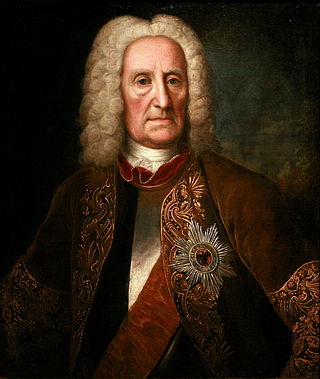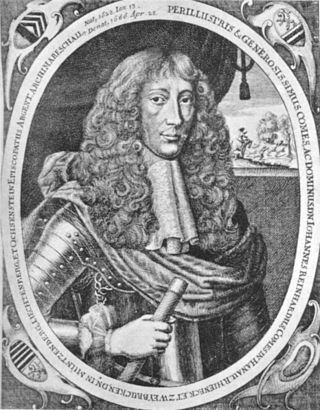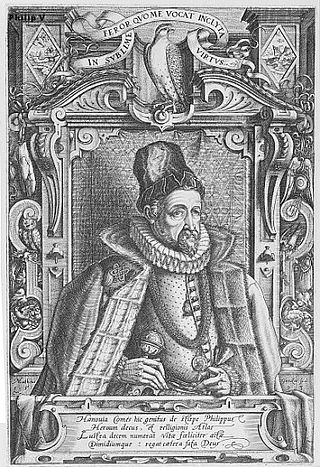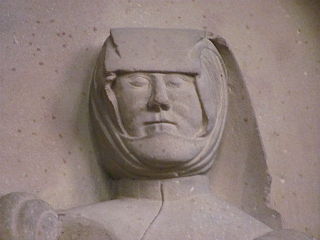
Johann Reinhard III of Hanau-Lichtenberg was the last of the counts of Hanau-Lichtenberg. He reigned from 1680 to 1736. From 1712 to 1736, he also reigned the County of Hanau-Münzenberg.

Count Johann Reinhard II of Hanau-Lichtenberg was a younger son of Count Philipp Wolfgang of Hanau-Lichtenberg (1595–1641) and Countess Johanna of Oettingen-Oettingen.
Philipp Wolfgang was a count of Hanau-Lichtenberg. He ruled the county from 1625 until his death.

Count Johann Reinhard I of Hanau-Lichtenberg ruled the county of Hanau-Lichtenberg from 1599 to 1625.
Philipp III of Hanau-Lichtenberg was the third Count of Hanau-Lichtenberg.

Philipp V of Hanau-Lichtenberg was Count of Hanau-Lichtenberg from 1590 until his death.
Ludowika Margaretha of Zweibrücken-Bitsch, was the only child and heiress of Count James of Zweibrücken-Bitsch by his wife Catherine, born Countess of Honstein zu Klettenberg. She was buried in Ingwiller.
Philipp IV of Hanau-Lichtenberg was from 1538 to 1590 the reigning Count of Hanau-Lichtenberg. Before his accession he had already conducted government business on behalf of his father, Count Philipp III. He was very interested in alchemy.

Friedrich Casimir of Hanau was a member of the Hanau-Lichtenberg branch of the House of Hanau.

Philipp I, Count of Hanau-Lichtenberg was Count of Hanau. The county was divided between him and his nephew, Count Philipp I "the Younger". Philipp the Elder's part of the county was later called Hanau-Lichtenberg; Philipp the Younger's part is known as Hanau-Münzenberg.

Count Philipp I of Hanau-Münzenberg, nicknamed Philipp the Younger, was a son of Count Reinhard III of Hanau and Countess Palatine Margaret of Mosbach. He was the Count of Hanau from 1452 to 1458. The county was then divided between him and his uncle Philipp the Elder. Philipp the Younger received Hanau-Münzenberg and ruled there from 1458 until his death.
Eleonore of Fürstenberg was a daughter of Count Frederick III of Fürstenberg. Eleanore was a convinced Protestant. However, she had little influence on the change of denomination in Hanau-Lichtenberg, due to her untimely death.
Count Johann Philipp of Hanau-Lichtenberg was a son of Count Philipp Wolfgang (1595–1641) and his wife, Countess Johanna of Oettingen-Oettingen (1602–1639).

Sibylle of Baden was a Margravine of Baden by birth and by marriage, Countess of Hanau-Lichtenberg. She was a daughter of Margrave Christoph I of Baden and his wife, Countess Ottilie von Katzenelnbogen, the daughter of Philip the Younger of Katzenelnbogen and thus a granddaughter of Philipp I, Count of Katzenelnbogen.
Elisabeth of Hanau was a daughter of Lord Ulrich V and his wife, Countess Elisabeth of Ziegenhain. She died on 25 May 1475 and was buried in the Gnadental monastery in Michelfeld.
Countess Anna Sibylle of Hanau-Lichtenberg was a German noblewoman. She was born in Lichtenberg, the eldest surviving daughter of Count Philipp IV and his wife, Countess Eleonore of Fürstenberg.

Johanna of Hanau-Lichtenberg, Countess of Eberstein was a German noblewoman, the eldest daughter of Philipp III, Count of Hanau-Lichtenberg and Margravine Sibylle of Baden.
Ludwig of Hanau-Lichtenberg was a German nobleman. He was a younger son of Count Philipp II and his wife Anna of Isenburg-Büdingen.
The County of Hanau-Lichtenberg was a territory in the Holy Roman Empire. It emerged between 1456 and 1480 from a part of the County of Hanau and one half of the Barony of Lichtenberg. Following the extinction of the counts of Hanau-Lichtenberg in 1736 it went to Hesse-Darmstadt, minor parts of it to the Hesse-Cassel. Its centre was in the lower Alsace, the capital first Babenhausen, later Buchsweiler.

Anna of Isenburg-Büdingen was a German noblewoman. She was a daughter of Count Louis II of Isenburg-Büdingen and Countess Maria of Nassau-Wiesbaden-Idstein.









